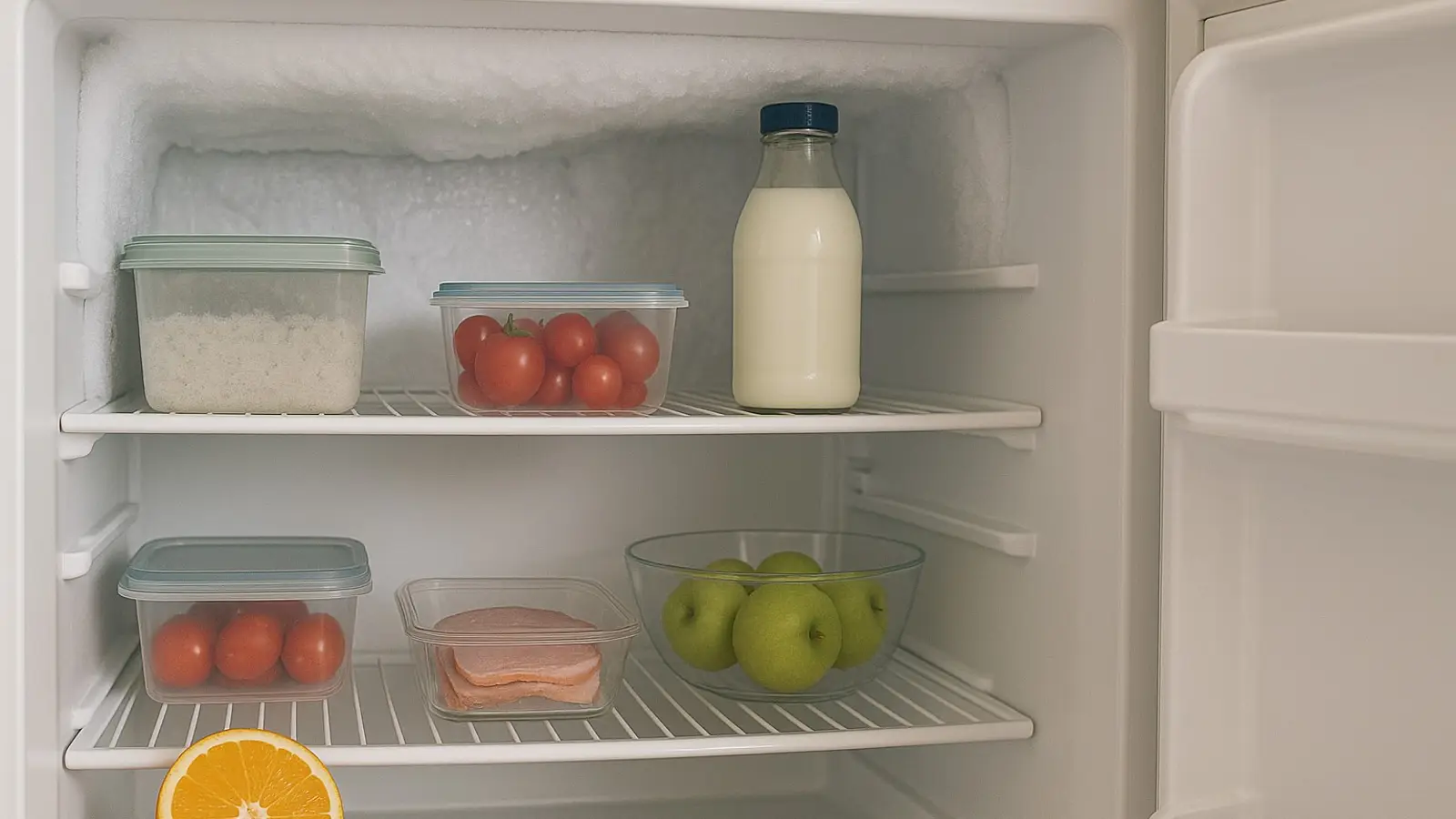https://boda.su/en/posts/id506-how-to-prevent-and-remove-refrigerator-frost-effectively
How to Prevent and Remove Refrigerator Frost Effectively
Simple Ways to Stop Frost Build-Up in Your Refrigerator
How to Prevent and Remove Refrigerator Frost Effectively
Learn the main causes of refrigerator frost and how to remove and prevent it. Easy steps to save energy, protect your fridge, and keep food fresh longer.
2025-09-26T12:20:33+03:00
2025-09-26T12:20:33+03:00
2025-09-26T12:21:34+03:00
Frost build-up inside a refrigerator is a problem many households know too well. It eats away at storage space, reduces the appliance’s efficiency, and drives up energy use. To keep your fridge working smoothly, it’s essential to understand why frost forms and how to deal with it effectively.
Main Causes of Frost Formation
Loose or worn door seal
When the rubber gasket is damaged or dirty, warm air slips inside. The moisture condenses and quickly turns to ice.
Frequent door opening
Every time the door swings open, humid air enters. On the cold walls, this moisture freezes — especially during hot summer days.
Placing hot food inside
Warm meals raise humidity levels and accelerate ice formation.
Incorrect temperature settings
The optimal range is +3 to +5°C for the fridge compartment and around -18°C for the freezer. Colder settings make frost appear faster.
Clogged drain hole
If the drainage channel is blocked, water has nowhere to go and eventually freezes.
Faulty thermostat or sensor
When the control sensor malfunctions, the system overcools, causing ice build-up.
Poor air circulation
Overloaded shelves restrict airflow. As a result, frost can appear in certain areas.
Defrost system failure
If the automatic defrost feature stops working, frost layers will grow continuously.
Power fluctuations
Unstable voltage disrupts the compressor’s performance and can lead to frost.
How to Remove Frost
Disconnect the fridge from the power supply and take out all the food.
Place a container for melted water and lay towels on the floor.
Let the ice melt naturally, or speed things up by putting a bowl of warm water inside.
Avoid scraping off ice with sharp tools — this may damage the interior walls.
Once the ice is gone, wipe surfaces with a soft cloth, warm water, and mild detergent. Dry thoroughly.
Check and clean the drain hole if needed.
Switch the fridge back on and wait until it reaches the right temperature before restocking food.
How to Prevent Frost
Regularly check if the door seals tightly.
Limit how often you open the fridge.
Let hot dishes cool down before storing.
Keep an eye on temperature settings.
Clean the drainage channel from time to time.
Arrange food so it doesn’t block air circulation.
Following these steps helps keep your refrigerator in top condition, lowers electricity costs, and ensures your food stays fresh for longer.
Refrigerator Frost, Remove Frost, Prevent Frost, Fridge Maintenance, Energy Saving, Refrigerator Care, Frost Build-Up, Fridge Efficiency, Food Freshness
2025
articles
Simple Ways to Stop Frost Build-Up in Your Refrigerator
Learn the main causes of refrigerator frost and how to remove and prevent it. Easy steps to save energy, protect your fridge, and keep food fresh longer.
Generated by Dall-e
Frost build-up inside a refrigerator is a problem many households know too well. It eats away at storage space, reduces the appliance’s efficiency, and drives up energy use. To keep your fridge working smoothly, it’s essential to understand why frost forms and how to deal with it effectively.
Main Causes of Frost Formation
Loose or worn door seal
When the rubber gasket is damaged or dirty, warm air slips inside. The moisture condenses and quickly turns to ice.
Frequent door opening
Every time the door swings open, humid air enters. On the cold walls, this moisture freezes — especially during hot summer days.
Placing hot food inside
Warm meals raise humidity levels and accelerate ice formation.
Incorrect temperature settings
The optimal range is +3 to +5°C for the fridge compartment and around -18°C for the freezer. Colder settings make frost appear faster.
Clogged drain hole
If the drainage channel is blocked, water has nowhere to go and eventually freezes.
Faulty thermostat or sensor
When the control sensor malfunctions, the system overcools, causing ice build-up.
Poor air circulation
Overloaded shelves restrict airflow. As a result, frost can appear in certain areas.
Defrost system failure
If the automatic defrost feature stops working, frost layers will grow continuously.
Power fluctuations
Unstable voltage disrupts the compressor’s performance and can lead to frost.
How to Remove Frost
- Disconnect the fridge from the power supply and take out all the food.
- Place a container for melted water and lay towels on the floor.
- Let the ice melt naturally, or speed things up by putting a bowl of warm water inside.
- Avoid scraping off ice with sharp tools — this may damage the interior walls.
- Once the ice is gone, wipe surfaces with a soft cloth, warm water, and mild detergent. Dry thoroughly.
- Check and clean the drain hole if needed.
- Switch the fridge back on and wait until it reaches the right temperature before restocking food.
How to Prevent Frost
- Regularly check if the door seals tightly.
- Limit how often you open the fridge.
- Let hot dishes cool down before storing.
- Keep an eye on temperature settings.
- Clean the drainage channel from time to time.
- Arrange food so it doesn’t block air circulation.
Following these steps helps keep your refrigerator in top condition, lowers electricity costs, and ensures your food stays fresh for longer.

